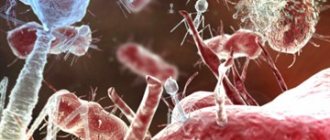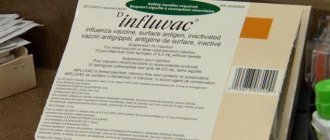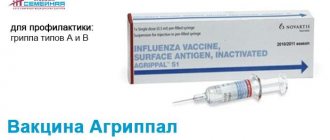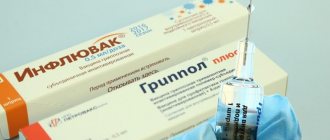Why are they offering to get vaccinated now, when the flu has not yet arrived?
The influenza virus is seasonal.
Its activity usually begins in late November - early December, and the peak incidence occurs in January-February. In order to develop protective immunity, vaccination must be done in advance - it takes 2-3 weeks for immunity to form. Now is the best time for vaccination. I would also like to note that influenza, unlike other respiratory viral infections, along with the new coronavirus, still causes many complications. Vaccination is exactly the way to prevent the development of such serious complications as, for example, pneumonia.
Is it possible to become infected with the new coronavirus “through a vaccine”?
This possibility is excluded because the vaccines developed in Russia and the USA do not contain the live SARS-CoV-2 virus:
- In Russian clinics, patients are most often offered to be vaccinated with the Sputnik V vaccine, developed by the NICEM. N. F. Gamaleya. It was created using the human adenovirus vector platform - this technology has been around for a long time and is well studied. The bottom line is that the genes through which it causes the disease are removed from the adenovirus and the gene of the new coronavirus is inserted. It encodes a protein in response to which an immune response develops.
- EpiVacCorona is also a Russian vaccine, it was developed by scientists from the Novosibirsk Scientific Research Center. There are no viruses in it at all. It is prepared from peptides - fragments of viral proteins. This is an innovative technology and is considered very safe.
- Two American vaccines - Pfizer and Moderna - contain viral RNA. It penetrates cells and causes them to synthesize a viral protein that causes an immune response. There is no live virus here either.
How to protect yourself from the flu if you have no opportunity or desire to get vaccinated?
Flu is an airborne infection, so the main prevention is to prevent the spread of the virus from a sick person to a healthy person. Therefore, all the protective measures that we recommend against COVID-19 will help against the flu: wear a mask, avoid participating in public events, especially indoors, try not to touch contaminated surfaces, protect your hands with gloves and, of course, wash your hands more often.
In addition, it is important to strengthen natural immunity. This is ensured by walks in the fresh air, proper nutrition, taking vitamins, and physical activity.
What do Western experts say?
In December 2021, experts from the American Society of Clinical Oncology (ASCO) said that the Pfizer and Moderna vaccines have been shown to be highly safe in the general population and there is no reason to believe they would be harmful to cancer patients.
Interim clinical recommendations for RNA vaccines against the new coronavirus have been published on the website of the US Centers for Disease Control and Prevention (CDC). They were last updated on January 21, 2021, and contain the following phrase:
“Immune-compromised people can get vaccinated against COVID-19 if they have no contraindications to vaccination. However, they should be informed of the unknown safety and effectiveness profile of the vaccine in immunocompromised populations, as well as the possibility of decreased immune responses and the need to continue to follow all current recommendations for protection against COVID-19.”
This also applies to people who are currently undergoing chemotherapy, radiation therapy, or stem cell transplantation. Based on a specific clinical situation, the doctor may well decide that such a patient can be vaccinated.
Experts note that due to a weakened immune system, post-vaccination immunity may be weak or not develop at all. However, it will be better than without vaccination. Vaccination, if there are no contraindications to it, really helps reduce the risk of infection and severe course of COVID-19.
Pfizer's vaccine trials have already included cancer patients, although they were a small number. However, available evidence suggests the vaccine is safe. Of course, some side effects may occur, just like in healthy people, but they are almost always mild and go away quickly. In addition to other side effects, temporary enlargement of the subcutaneous lymph nodes is possible - this was observed in 0.4% of trial participants. An oncology patient may become frightened and decide that the disease has begun to progress and a metastasis has appeared. Otherwise it is not dangerous. However, caution should be exercised in patients with lymphedema, which is swelling that occurs after removal of lymph nodes.
Who needs flu shots first?
We have a national vaccination calendar, which provides for priority vaccination of risk groups for influenza infection. Firstly, these are the most susceptible people - children of preschool and school age, as well as people who, due to their professional background, encounter infected people - doctors, teachers, transport workers, sellers and cashiers. This also includes people living in residential institutions.
The second risk group is determined by people with chronic somatic diseases, as well as pregnant women. Of course, infection with any respiratory infection can lead to exacerbation of chronic diseases, and in the case of influenza and COVID-19, chronic patients are more likely to develop severe complications, in some cases leading to death. Flu also causes an increase in mortality, which for some reason we often forget about.
Vaccination reduces the risk of influenza infection, and if infected, the disease is more mild.
Recommendations for caring for patients at home
- Isolate the sick person from others, at least 1 meter away from others.
- Cover your mouth and nose when providing patient care using masks.
- Wash your hands thoroughly with soap and water after each contact with someone who is sick. Provide separate towels for each family member.
- Apart from caregivers, the patient should not have any visitors.
- If possible, only one adult in the home should provide care.
- Avoid having a pregnant woman care for the patient.
- Constantly ventilate the room in which the patient is located.
- Keep the area clean using detergents.
Recommendations for parents of sick children
- If your child becomes ill, seek medical attention from a doctor.
- Leave a sick child at home unless he or she needs medical attention.
- Give your child plenty of fluids (juice, water).
- Create a comfortable environment for your child; peace is extremely important.
- If your child has a fever, sore throat and body aches, you can give him antipyretics, which the doctor will prescribe based on the patient's age.
- Keep tissues and a trash bin for used tissues within the patient's reach.
- Teach children to wash their hands frequently with soap and water for 20 seconds. Parents should also follow this procedure, which will serve as a good example for children.
- Teach children to cough and sneeze into a tissue or hand. Parents should also follow this procedure, which will serve as a good example for children.
- Teach children not to approach sick people closer than one and a half to two meters.
- Sick children should stay home (not attend preschools or schools) and keep their distance from other people until their condition improves.
- Refrain from frequent visits to crowded places.
- If your child has been in contact with someone who has the flu, ask your doctor about the need to take antiviral medications to prevent illness.
/upload/iblock/8fb/8fb3203939955ff7f105f494ffa830a6.pngPHP code» data-counter>
Many people are afraid to get vaccinated because of side effects. To what extent are such fears justified?
Modern flu vaccines are completely safe and slightly reactogenic (that is, do not cause side effects). In addition, most vaccines are inactivated, meaning they do not contain live virus. Therefore, vaccination cannot cause respiratory disease.
But an allergic reaction is still possible. Therefore, it is advisable for allergy sufferers and people with other autoimmune diseases to consult a doctor before vaccination.
A flu shot is also needed so that if you suddenly “catch” the coronavirus, the two infections do not overlap one another.
Is suffering inevitable?
Last year we were afraid of getting sick from Covid and waited for the vaccine to appear; this year we are worried about the risks of vaccination. People talk about the side effects of vaccinations in kitchens, in chat rooms, and ask questions in comments on “Covid” news. We have collected some of them to discuss in this text. We will talk mainly about coronavirus vaccines, which are already widely used in Russia, European countries and the United States; very little is known about Asian drugs. Let's find out if all vaccines have side effects and if it's true that coronavirus vaccines are "evil" than all others.
- Do all vaccines have side effects?
- Side effects from the coronavirus vaccine - is it Covid in miniature?
- Is it true that all available coronavirus vaccines are more difficult to tolerate than others?
- Are the severity of side effects of the available coronavirus vaccines the same?
- Is the second injection necessarily worse tolerated than the first?
- They write that there are practically no serious side effects from the vaccine, and all my friends felt “very ill” after the injection! Are the developers lying?
- If there are no side effects, then the vaccine did not work
Do all vaccines have side effects?
Yes.
A vaccine is a medicine, and any medicine can cause side effects. Share
Side effects are any reaction to a medicine other than the reason you are taking it. The body can react to both the active ingredient of the medicine and the auxiliary one - for example, some people are allergic to preservatives in medicinal ointments.
In the event of an undesirable reaction to the active substance, two scenarios are possible. It can influence not only the target process, but also other processes occurring in the body. For example, diphenhydramine “plugs” histamine receptors, which are in the blood vessels and on the sensory nerves of the respiratory tract. When histamine binds to the receptors, allergy symptoms occur: nasal congestion, swelling, redness of the skin and cough. Diphenhydramine cancels allergic symptoms, but at the same time suppresses the activity of acetylcholine. This causes drowsiness and other unexpected effects like dry mouth.
It also happens that a substance acts on one target, but this causes several effects at once. For example, some antidepressants activate serotonin receptors, which improves mood but also impairs sleep.
In the case of classical vaccines, which have been widely used since the twentieth century, side effects can also occur as a result of a reaction either to the active substance or to excipients. Their active substance is weakened viruses and bacteria or their “pieces,” that is, proteins or peptides. By vaccinating, we “feed” them to the immune system to train it to fight the pathogen. Ideally, a vaccine's active ingredient should be a harmless training aid for immune cells. However, immunity is a complex thing. Therefore, once in the body, vaccine components sometimes still cause unwanted reactions.
This can be illustrated by the example of tetanus toxoid, a component of the adsorbed diphtheria-tetanus-pertussis vaccine (DTP). Toxoid is a protein produced by the bacteria that causes tetanus. When a person is vaccinated, his immune cells react to the toxoid, that is, they begin to produce antibodies to it. An immune attack on the toxin is accompanied by mild local inflammation: the injection site becomes warm, red and sore, and a swelling less than one centimeter in diameter appears around. After a few days the discomfort goes away.
However, high levels of antibodies to tetanus toxoid usually do not last long. To consolidate success, a person is vaccinated many times - the first four shots are given to children aged three, four and a half, six and 18 months, and they receive the next dose at six years, then at 14. Most six-year-old children and 14-year-old adolescents They endure the next injection in the same way as the first injection. However, in the rare “lucky” people who still have a high level of antibodies, a new portion of tetanus toxoid begins to react with the antibodies already present in the body, forming immune complexes in the walls of small arteries.
As a result, the immune response to the second injection is not limited to local discomfort (most likely because immune complexes damage the vascular wall or cause inflammation). In addition to the fact that the red swelling becomes more than eight centimeters in diameter, the arm swells and hurts quite a lot, the re-vaccinated person feels unwell for several days after the injection and has a fever. But after a few days, these side effects also disappear.
From the editor
This text has been updated to include
: In the original version of the text, we described the frequency of tetanus vaccinations based on American health care practices. Now, instead, the vaccination schedule is based on the National Calendar of Preventive Vaccinations in the Russian Federation.
Share
In addition, during the production of classical vaccines, stabilizers are added to them. For example, the MMR vaccine, which protects against measles, mumps and rubella, contains gelatin. And some substances get into vaccines during the production process - for example, a flu vaccine that is grown in chicken embryos may contain egg white. Both can cause allergies in some people. True, in practice this happens so rarely that allergies to gelatin and eggs are not a contraindication for vaccinations. Vaccination is carried out under the supervision of a doctor who is able to recognize allergic conditions in time and cope with them.
The coronavirus vaccines that are now being used for mass vaccination are designed differently - these are next-generation technologies - but their side effects are associated with the same thing, with immune activation and inflammation. And they are mainly related to the active substance, and not to the excipients, because the Pfizer/BioNTech, Moderna, and AstraZeneca vaccines do not contain “classic” vaccine allergens such as stabilizers and egg whites.
However, cases of anaphylaxis after receiving the Pfizer/BioNTech and Moderna vaccines do occur, although they are extremely rare: 4.7 cases per million Pfizer/BioNTech doses administered and 2.5 cases per million Moderna doses administered. In some people, the reaction appeared immediately, while in others it was only half an hour after vaccination. That is why vaccinated people are advised to wait in the corridor for 30 minutes - this is a good practice, considering that all the people who experienced anaphylaxis after the injection were saved. It is not yet clear which component of vaccines leads to an allergic reaction. It has been suggested that the problem may be propylene glycol, which is included in both mRNA vaccines, but there is no clear answer to this question; the developers are conducting appropriate tests.
The creators of the Sputnik V vaccine did not report any anaphylactic reactions. In a study of vaccine safety and effectiveness, 14 people (0.151 percent) of 9,258 participants who received the drug rather than a placebo reported an allergic reaction. Although the risk of getting an allergy after vaccination is very small, in our country after the injection you will also need to wait in the corridor for half an hour - just to be on the safe side. If an allergic reaction does occur, the doctor will have time to help.
Return to top
Side effects from the coronavirus vaccine - is it Covid in miniature?
No. Not a single coronavirus vaccine that is currently used for mass vaccination causes the body to get sick with Covid, even in a weakened form. They do not contain the whole SARS-CoV-2 virus, which could infect a cell and begin to multiply in it. A “live” vaccine can give a similar effect, but no one will give you such a vaccine against coronavirus - according to WHO data as of February 18, it is being developed in India, but it has not yet gone beyond the first stage of clinical trials.
Share
To understand, you will have to say a few words about what exactly the SARS-CoV-2 coronavirus does in the body. First, the virus binds to target cells. Any cells in our body that have the ACE2 receptor are suitable for it. Having hooked onto the ACE2 receptor with its spike proteins, the virus enters the cell and begins to multiply in it. The invasion of the virus triggers a complex immune response: an inflammatory reaction develops, and specialized immune cells begin to destroy their counterparts affected by the virus.
If, as is most often the case, active replication and release of the virus occurs in lung cells, a person experiences flu-like symptoms: fever, muscle pain, headache, nasal congestion and runny nose. In some patients, the immune response becomes uncontrollable and inflammation becomes excessive—researchers call this a “cytokine storm.” Some complications of coronavirus disease, such as respiratory failure, are believed to be associated with this condition.
None of the vaccines that are now widely used in the world have such an effect on the body. At the same time, coronavirus vaccines are divided into several groups (depending on technology), and it makes sense to consider each of them separately.
Adenovirus vaccines
: Russian vaccine “Sputnik V”, also known as Gam-COVID-Vac, British vaccine ChAdOx1 (which was created by AstraZeneca together with Oxford University), Chinese vaccine from CanSino Bio.
Adenoviral vaccines are created on the basis of adenoviruses, the genome of which has been modified: a section of the genome of the SARS-CoV-2 coronavirus has been included and a number of “relatives” have been disabled. The adenovirus enters the cell and unpacks its genetic material, which causes the cells to create the spike protein that makes up the spikes of SARS-CoV-2. After this, the cell cuts the spike protein into pieces and displays them on its surface - thanks to this, immune cells can encounter them, recognize them as harmful and learn to fight them. At the same time, the modified adenovirus does not cause either coronavirus or “adenoviral” disease - the genes responsible for pathogenicity and reproduction are cut out of it.
The mechanism that adenovirus vaccines trigger in our body is very similar to a full-fledged immune response to a real viral infection. The immune response is a very complex dance in which immune cells from different combat teams exchange signaling molecules and direct each other’s actions (for more information about how the immune response to coronavirus works, you can read the article “Will we remember it?”). The immune response also involves immune cells and molecules responsible for the inflammatory reaction, so a vaccinated person experiences some of its manifestations: fever, general malaise, and muscle pain.
Coronavirus messenger RNA (mRNA) vaccines
: BNT162b2 (Pfizer/BioNTech) and mRNA-1273 (Moderna).
Vaccines based on messenger RNA are the most interesting. Messenger RNA is the instruction that cells use to “print” proteins. Vaccine creators synthesized coronavirus messenger RNA, which is responsible for creating the spike protein, and enclosed it in a lipid nanoparticle. Once in the human body, the nanoparticle merges with the membranes of its cells, and the “instructions” for creating the coronavirus spike protein enter the cell.
And since the messenger RNA of the coronavirus is no different from the “native” messenger RNAs, the cell takes it into service and begins to independently create the spike protein. As a result, a constant source of “training material” for the immune system appears in the body, despite the fact that neither the coronavirus itself nor its fragments have even entered the body. This cannot be called a “disease in miniature”.
As with adenovirus vaccines, the immune response to mRNA vaccines involves the entire immune system. It also involves cells and substances that provoke inflammation. So the side effects of coronavirus mRNA vaccines will be approximately the same as those of adenovirus vaccines.
Peptide vaccines
: Russian EpiVacCorona.
The peptide vaccine “consists of artificially synthesized short fragments of viral proteins - peptides that are recognized by the immune system.” The active ingredient of the vaccine is pieces of the coronavirus spike protein. To cause disease, you need an entire coronavirus to enter cells and force them to produce new copies of the virus. And fragments of the spike protein alone can cause an immune reaction in the human body, but cannot provoke disease, because the proteins cannot get inside cells and begin to multiply there.
Unlike vector vaccines, the active substance of EpiVacCorona does not penetrate the body's cells and simply remains in the bloodstream. As a result, the vaccine does not trigger a full immune response, but only part of it - the one that reacts to viral antigens. This, of course, reduces the effect of vaccination: participants in phase III clinical trials of EpiVacCorona even turned to the Ministry of Health, Rospotrebnadzor and the vaccine developers with an open letter in which they complained about the lack of antibodies in 33 percent of the subjects (the placebo-treated study participants should have been 25 percent ).
On the other hand, side effects from the peptide vaccine are also minimal, because not the entire immune system took part in the “mandatory work” to protect against infection, but only that part of it that is responsible for creating antibodies. A letter on the Rospotrebnadzor website states that only some volunteers “had short-term minor pain at the injection site, which arose a day after vaccination and lasted for 1-2 days.” There are no publications by the vaccine creators themselves that would describe the results of clinical trials of EpiVacCorona and its side effects.
There are also inactivated vaccines
against coronavirus, this is exactly the traditional technology that we talked about above: the Russian development of the Chumakov Center (read more about it in the material “Dead Water”), Indian and four Chinese - for example, a vaccine from the CNBG company. Inactivated vaccines use “dead” coronaviruses that cannot reproduce in the body and, therefore, cause disease. Some of the inactivated vaccines are still at the stage of clinical trials - and in India they have already begun to vaccinate people en masse, without waiting for the end of the clinical trial.
Although inactivated vaccines have been deemed safe enough to be given to people, very little is known about their side effects.
To say anything for sure, we need to wait for the report on phase III clinical trials of at least one such vaccine. Return to top
Is it true that all available coronavirus vaccines are more difficult to tolerate than others?
Yes. In comparison, coronavirus vaccinations are more difficult to tolerate than vaccinations against influenza, measles, mumps and rubella, and pneumococcal infection.
Share
The American Center for Infectious Disease Control and Prevention (CDC) writes that among those vaccinated with the Pfizer/BioNTech and Moderna vaccines, 80-89 percent had at least one local side effect, and 55 percent had at least one systemic side effect. -83 percent vaccinated.
This is a lot: for comparison, among people vaccinated against influenza, a week after vaccination, only 14.2 percent of those vaccinated complained of fever and general ill health; after vaccination against measles, mumps and rubella, 5-15 percent complained of fever, and rash - 2–5 percent. Even the “record holder” among classical vaccines, the pneumococcal vaccine, caused pain at the injection site in 60 percent of cases, swelling at the injection site in 20 percent of cases, and headache, weakness and muscle pain in 17.6, 13.2 and 11.9 percent of cases, respectively.
Side effects of the Pfizer/BioNTech vaccine:
- local - pain, swelling and redness at the injection site, enlarged lymph nodes under the armpit of the arm in which the injection was given;
- systemic - general malaise, fatigue, fever, chills, nausea, headache, pain in joints and muscles.
Side effects of the Moderna vaccine:
- local - pain, swelling and redness at the injection site, soreness and enlargement of the lymph nodes under the armpit of the arm in which the injection was given;
- systemic - fatigue, fever, chills, nausea and vomiting, headache, pain in joints and muscles.
Both mRNA vaccines can cause severe allergies. But this happens very rarely: in about 11 cases per million vaccinated people.
In an interim analysis of the phase III clinical trial of Sputnik V, the makers of the Russian vaccine said the analysis of overall safety and rare adverse events included 12,296 participants who received both doses of the vaccine. Side effects occurred in 7966 people. Of these, grade 1, or mild, symptoms were observed in 7,485 people (94 percent of participants), grade 2, or moderate, symptoms were observed in 451 people (5.7 percent), and grade 3, severe side effects were observed in 30 people (0.4 percent).
Most often, those vaccinated with the Center’s vaccine. Gamaleya people complained of influenza-like illness (15.2 percent of participants), local reactions at the injection site (5.4 percent), headache and weakness. The review showed that reported events such as exacerbation of urolithiasis and acute sinusitis were not associated with vaccination. There have been no vaccine-related deaths.
So far, nothing is really known about the side effects of peptide vaccines, because large-scale vaccination with EpiVacCorona has not yet begun. So there is simply no data yet.
Return to top
Are the severity of side effects of the available coronavirus vaccines the same?
There is a difference, but small. As we have already seen, the set of unpleasant symptoms in foreign and Russian vaccines is very similar. The only difference is the time that all this will have to be endured.
Share
In people who received messenger RNA vaccines, adverse reactions occurred on average one to two days after the shot. But for those vaccinated with Pfizer/BioNTech, everything went away on average in one day, and for those vaccinated with Moderna - in two to three days. For comparison, in those vaccinated with Sputnik V, judging by the instructions for the vaccine, mild and moderate side effects occurred on the first or second day after vaccination and disappeared over the next three days. It is impossible to say with certainty what this difference is due to.
Return to top
Is the second injection necessarily worse tolerated than the first?
This is indeed true for messenger RNA vaccines. In both people vaccinated with Pfizer/BioNTech and people vaccinated with Moderna, systemic adverse reactions were reported more often after the second dose of the vaccine than after the first. There is no such data yet about Sputnik V.
Share
For the vaccine to work better, people receive several vaccinations - in the case of coronavirus disease, we are talking about two injections. Multiple immunizations are called “prime boosts.”
To simplify a little, the first dose of the vaccine activates immunological memory, and the second strengthens it. When a person is given the first vaccination, the body is not yet ready to meet the pathogen and reacts rather “sluggishly”. In the 21 days that must pass from the moment of the first vaccination, the immune system “accumulates strength.” And when, after the second injection, it is again found in the vaccine, the immune reaction is much more powerful. This means that the side effects may be more severe.
Return to top
They write that there are practically no serious side effects from the vaccine, and all my friends felt “very ill” after the injection! Are the developers lying?
Different people perceive pain and discomfort in different ways: someone will think that after the vaccination he almost died, while someone in the same circumstances will decide that he felt practically nothing. But “almost died” is a subjective experience. And doctors have standards and protocols for assessing what is bad and how bad someone is. And when they say something about the side effects of the vaccine, they refer to these standards. This is where the “virtual absence” of severe side effects comes from.
Share
Pfizer/BioNTech, Moderna and the Center named after. The Gamaleyans used the Standardized Toxicity Score, an international guideline that helps assess the severity of side effects in healthy adult volunteers, in clinical trials of their vaccines.
According to it, the severity of side effects is divided into four degrees: mild (grade 1), moderate (grade 2), severe (grade 3) and potentially life-threatening (grade 4). Each degree has its own criteria. For example, a mild fever is a body temperature in the region of 38-38.4 °C, moderate - from 38.5 to 38.9 °C, severe - 39-40 °C, and potentially life-threatening - above 40 °C.
When vaccine makers write that vaccinated people had no serious adverse events, this means they did not experience grade 3 or 4 side effects. Continuing with the fever example, this means that no study participant had a temperature above 39°C. But from 38.5°C to 38.9°C - please.
If after vaccination you feel weak, your temperature rises to 39°C, the injection site and muscles hurt, you can take an over-the-counter antipyretic or pain reliever: an ibuprofen or paracetamol tablet. In three days everything should go away.
But if, a day after the injection, redness or soreness in the area begins to intensify, or if the discomfort associated with the vaccination does not go away after three days, it makes sense to consult a doctor.
Return to top
If there are no side effects, does that mean the vaccine didn’t work?
Whether the complete absence of side effects could be due to the fact that the vaccine did not work at all is unknown. The vaccines have undergone clinical trials and their effectiveness has been shown in fairly large samples. Therefore, if you don’t feel anything at all, this does not mean that nothing is happening.
Share
Most experts around the world actually believe that side effects after vaccination occur as a result of the body's immune response to the vaccine. If anything, the CDC reports that for both the Pfizer/BioNTech and Moderna vaccines, people ages 18-64 suffered side effects more often than people over 65. Perhaps the whole point is that with age, the intensity of the immune response to foreign antigens decreases. However, the effectiveness of vaccines in older people has not been studied enough, so we cannot say for sure how well the vaccines work in them.
However, if you are under 65 years old and do not feel anything special after the injection, this does not mean that the vaccine did not work. Every person is different, and the intensity of the immune response may also vary.
Return to top
Daniil Davydov
Can a flu vaccination boost immunity against coronavirus?
Such a hypothesis exists, but needs to be tested. This epidemic season will give us the answer to this question. The only thing that can be said is that when vaccination is carried out (this has been noticed before), within one month after vaccination the number of other respiratory diseases decreases.
When vaccinated, the body reacts not only by developing specific immunity to the influenza virus, but also increases other immunity factors, so “double” protection, although not one hundred percent, is possible.
Is it possible to be vaccinated with an imported vaccine?
“It is impossible to vaccinate against flu with a foreign vaccine in any clinic!” — there are quite a lot of such indignant messages on social networks. Just a few years ago, people had a choice - to get vaccinated for free with a Russian drug or go to a commercial clinic, pay and get vaccinated with an imported vaccine. But now the situation has changed: foreign pharmaceutical companies do not participate in government procurement (there are many Russian manufacturers of influenza vaccines, and according to the “third wheel” rule, foreigners are simply not allowed to bid).
Foreign companies are not prohibited from providing vaccines to private clinics, but it is not so simple: the flu vaccine is a perishable product, if not in great demand (and the majority of the population is still vaccinated with domestic drugs), surpluses have to be destroyed, and suppliers incur losses. But all this is of little interest to those who want to get vaccinated. And although infectious disease specialists and immunologists assure that the effectiveness and safety of our flu vaccines has been proven by time and is not inferior to drugs from abroad, those who are accustomed to being vaccinated with the same vaccine year after year do not want to change it.
So will a “foreign” vaccine still be available? We addressed this question to the French company Sanofi - this year only in September, when the questions began, they confirmed that there would be deliveries, but later. This is the answer “RG - Nedelya” received.
“Sanofi Pasteur, the vaccine business unit of Sanofi, is a socially responsible partner of the Russian government, and we have been supplying our vaccines to Russia for over 25 years,” says Yuri Mochalin, Sanofi’s director of corporate affairs for the Eurasian region. — The company sees its strategic role in the production of vaccines to meet demand in the Russian market. Every year, in anticipation of the high flu season, Sanofi Pasteur supplies Russia with its flu vaccine, and in 2021 we continue to do so. The flu vaccine has arrived in the country, has undergone the procedure for introduction into civilian circulation and is available for shipment from the warehouse of Sanofi Russia JSC.
The vaccine will be supplied as usual through our traditional distribution network. To clarify details, you must contact distributors, medical centers, and pharmacies.”









